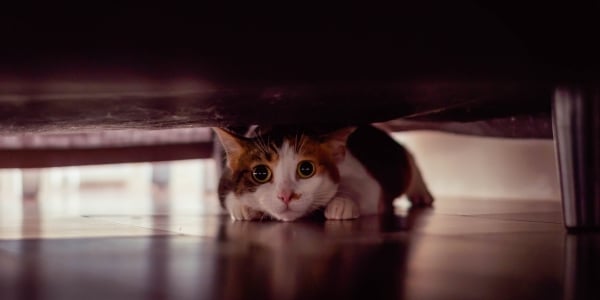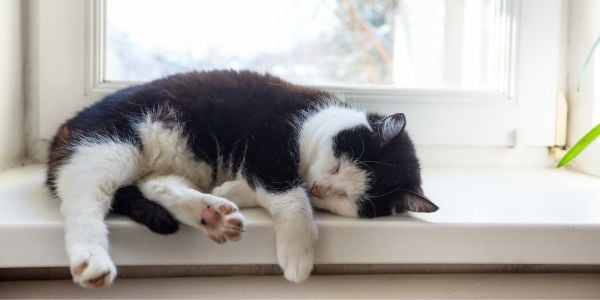
Stress is a common issue with even the most mellow cats. That’s because cats are furry little stress sponges. They’re great at holding on to their own stress, and they can even soak up our stress.
If the stressors continue or they don’t have ways of reducing stress, it can really start to impact their emotional and physical health.
That’s why it’s important to know how to recognize and address stress in your kitty.
Skip to section:
Why It’s Important to Manage Your Cat’s Stress
Stress can cause a lot of issues for your cat. Some are mental and emotional. Others are medical. And just like humans, it can be circular. Stress and anxiety can cause medical issues. Medical issues can cause stress.
The Negative Impact of Stress on a Cat
Here are a few of the negative impacts stress can lead to:
Emotional changes
Your cat may become less affectionate or playful. They may not find pleasure in the things they used to. Those things that used to help reduce stress, like play and snuggles, no longer feel safe, which, in turn, increases stress even more.
Increased nervousness and decreased confidence
A stressed cat will often become more skittish and stay on alert much of the time. They tend to tune into their prey side more during these times, which means they’re ready for fight-or-flight at any moment.
Aggression and reactivity
That added nervousness can lead to hiding, being more reactive, and even fear aggression if they feel they’re in danger.
House soiling and spraying
Stressed cats often soil or spray as a way to get our attention and tell us something is wrong. They also use it to surround themselves with their own scent, which is soothing.
Medical issues
Stress is a common cause of feline cystitis, changes in eating habits, diarrhea or digestive issues, poor grooming or self-mutilation leading to skin issues, and high blood pressure, which in time can lead to kidney disease. Overall, chronic stress lowers their immune system, increasing the likelihood of illness.
Compromised quality of life
A cat in a constant stress or fear state is struggling. They find it hard to let their guard down. It can take a toll.

Signs Your Cat Is Stressed
This is an area where cats and humans have a lot in common. There are many similarities in the way we handle stress. Here are some signs that could mean you have a stressed-out kitty.
Changes to Their 'Normal'
Cats are great at hiding things like stress, pain, and medical issues. The first clues we get are changes to their normal behavior. Luckily, you know your cat well. If you notice even small shifts in their normal behavior, pay attention. It may be a clue.
Soiling and Urination Issues
If your cat is peeing or pooping outside the litter box, or they’ve started spraying (usually recognized because it’s on vertical surfaces instead of horizontal), stress could be the cause. Get to your veterinarian first to rule out a medical cause (which can certainly increase stress). Then check out our article on how to stop house soiling.
If you notice your cat isn’t peeing as much or as often as they usually do, this can be a sign of a serious stress-related illness. Urethral obstruction is a very serious medical emergency. A cat that cannot pee is a cat that’s going to die unless appropriate veterinary medical care is obtained immediately.
Decreased Appetite
If your cat’s normal eating habits have suddenly changed, and they’ve started eating less (or even skipping meals altogether), this is an important sign – and one that can indicate stress, pain, or another serious problem. Again, a vet visit is your first priority to rule out a medical cause. Then, you can start looking at ways to reduce stress and getting them eating again.
Many people don’t notice a loss of appetite right away, especially if there are multiple cats in the household. Use the techniques in our article on weight loss to see if your cat is underweight.
Increased Vocalization
Many cats love to meow and even howl. But if you notice your cat vocalizing more than usual or even talking at different times, they might be trying to tell you that something is wrong. A vet visit can help rule out pain, discomfort, and cognitive issues.
Unexpected Aggression or Reactivity
If your mild-mannered cat has become more aggressive to people or other pets, they might be feeling the effects of stress or an underlying health issue. It’s best to have them looked at by a veterinarian and think about anything that may have changed in their environment recently — especially something that could cause fear.
Look for a stress trigger, like moving, or a new baby or pet in the home. Check out our article on how to deal with cat aggression.
Excessive Grooming and Other Obsessive Behaviors
Cats are capable of obsessive behaviors just like people, though they may take a slightly different form. Overgrooming is common. That can mean licking or chewing on their fur and skin, often leading to bald patches and even sores. However, it can take time to see the physical impact of hair loss and sores.
Take notice if your cat is suddenly paying a lot of attention to specific spots on their body.
They can also get obsessive about chewing, suckling (often on blankets), or really anything. What you’re looking for is an inability to easily distract them. If calling their name or tossing a toy doesn’t do it, and you have to physically force them to stop, or they go right back to it after they’re stopped, that’s an obsessive behavior that could be stress-related.
It could also mean an uncomfortable skin issue, pain, or another medical problem. You guessed it. Back to the vet for a checkup. Then, look at stress triggers and reduction.

Hiding and Nervousness
If your regularly active and affectionate cat suddenly starts hiding, becomes more skittish, plays less, isn’t as cuddly, or really anything outside their “normal,” — stress, pain, or another concerning condition could be to blame.
It can be a subtle sign, but one that you really shouldn’t miss or take a “wait-and-see” approach to. And for those cats who have always been shy or skittish, there’s a distinct possibility that they’re suffering from chronic stress.
Start with a vet visit to rule out medical causes. Look for stressors you can manage. And consider working with a certified feline training and behavior expert.
Clinginess
At the other end of the spectrum, some cats will become extra clingy when stressed. Again, it’s about looking for changes. If your cat is suddenly following you everywhere, getting anxious when you leave the room or close a door behind you, doing things to get your attention, etc., they may be stressed.
Panting
While dogs pant routinely and for a variety of reasons, cats generally aren’t panters. Panting in cats often means a problem. It can happen during extreme stress or fear. It’s also a clue that there may be a medical issue.
What to Do if You See Signs of Stress in Your Cat
You may have noticed a vet visit referenced often above. That’s because many stress signs overlap with clinical signs of medical issues. A vet visit is always your first priority unless you’re absolutely sure you know the cause of the stress.
Once your vet has ruled out medical issues or you’re working on any treatment plan they recommended, it’s time to think about stress. Remember, medical issues alone can trigger stress.
But even after the issue is resolved, the stress state can remain. So, you’ll want to look at stress reduction whether you’re dealing with a clear medical cause or not.
Ways to Reduce Your Cat's Stress
-
Any play is helpful, but prey sequence play is one of the most effective ways to reduce stress. Use a wand toy. Da Bird is our favorite. Our article on prey sequence play sessions will walk you through the basics.
-
Think about when you’re anxious. If you roll around in it, you feel worse. If you get up and do something, you feel better. It can work the same way for your cat. Use mental enrichment to give them fun things to do.
Food puzzles, hiding treats around the home for them to sniff out, training sessions, cat videos (check out our free YouTube videos for your cat's entertainment), and more can help fight boredom and reduce stress.
Check out our article on what to do if your cat is bored for more ideas.
-
Giving your cat a little extra love can go a long way to reducing stress. This is especially true if the stress trigger is a new person, child, or pet in the home or a change in your schedule. Don’t worry! It doesn’t have to take a lot of time.
Cats are high-frequency, low-intensity interactors. That means they like their special moments with you to be short, sweet, and often. Just taking a minute to scratch a chin while you wait for your tea to heat up or toss a toy on the way for a bathroom break is a quality interaction for your cat. -
Create safe spaces. Cats need high spots and hiding spots to feel safe. Having plenty of these throughout your home can help a nervous cat feel more comfortable coming out and moving around.
High spots can include cat shelves, cat trees, window perches (see my favorite perch below), or even spaces on tall furniture that have been cleared off and secured so they won’t tip over.Hiding spots can be simple, like cardboard boxes with a hole cut in the side or a dining chair with a blanket draped over it. You can purchase cat caves and tunnels. Even build your own cat condo with old Amazon boxes.
If your cat has mobility issues, keep their needs in mind. They may need lower openings to get into hiding spots and small steps leading up to high spots. Or they may just prefer to stay close to the ground, making ground-level hiding spots important.
This is my favorite window perch for cats. It's safe because it doesn't have any cords, and the suction cups are super strong. I was skeptical of the strength of them, but I've had zero issues, and my cat Ollie loves sitting in the window and looking out. -
While a pheromone spray or diffuser won’t eliminate stress on its own, they can be a helpful tool to layer into your plan.
-
Try calming treats and supplements. There are a variety of treats and supplements intended to reduce stress. In my experience, it’s a 50/50 shot. Some cats respond, while others don’t. It’s a good idea to talk to your vet and get their recommendations. Probiotics have been proven to help with anxiety as well as gastrointestinal issues, like diarrhea, so adding a daily probiotic could be a great addition to tackling both issues.
-
Try anxiety medication. For more serious situations, talk with your veterinarian about whether a prescription anxiety medication could be helpful. Many people are leery of “drugging” their cats. But think of it the same way you would if a friend needed prescription support for their anxiety.
The goal isn’t to knock your cat out or change their personality. You just want to turn the intensity down for them. For a cat who is really suffering with stress and fear, being able to take the edge off a bit can do wonders. It can even help the other stress reduction techniques have more of an impact. Be aware they can take time to work.It’s important to find a vet who will work with you on the right medication and dosage for the intended result. Medicating your cat doesn't have to be a challenge. Certain anxiety medications can be given transdermally, meaning you rub them on the ear. You can also check out this article for plenty of tips and tricks on how to give your cat a pill.
Some transdermal medications don't work as well as pills, so be sure to discuss this with your veterinarian.
A word of caution on CBD for anxiety. There are a lot of CBD products for pets nowadays. Please don’t try any of them without first talking with your vet. There hasn’t been much research on how these products affect cats.
The industry is not regulated. And the quality and ingredients can vary wildly! Unless my vet has researched a CBD product thoroughly and seen reports on the quality of the ingredients, I will not try them for my cat.

One of the most important ways to reduce stress is to find the trigger and work on it. That can mean removing it completely or helping your cat feel more comfortable with it. There are resources available to help you do that. We’ve included lots of links above to articles on specific issues and triggers. You can talk with your veterinarian.
There are also experts out there who specialize in this kind of work. Look for a certified training and behavior consultant or a veterinary behaviorist who can help you identify triggers and help your cat move past them.
There is a reason your cat is stressed. Even if they’ve always been a little jumpy, there are things you can do to help. And it’s worth it! The improvement in their quality of life can be profound.




